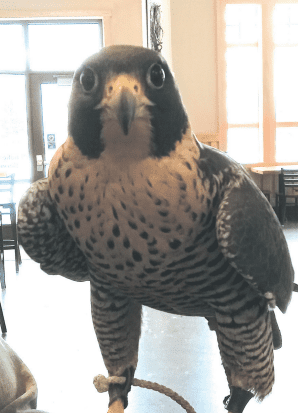On December 30th, Jackie Fallon of the Midwest Peregrine Society came to Tettegouche State Park with peregrine falcon Rhye and kestrel Juliet. Fallon gave a presentation about falcons and answered guests’ questions about the raptors.
Fallon was allotted education permits from the US Fish and Wildlife Service and the Minnesota DNR to handle Rhye and Juliet. Both falcons have been trained to serve as ambassador birds in educating the public. Fallon says, “Not every raptor has the right temperament to be comfortable in these situations [educational programs], but both Juliet and Rhye are excellent at their jobs.” They joined the education team after suffering injuries that prevent them from living in the wild. Juliet was a falconry bird that received an eye injury, leading to the loss of her eye. Rhye injured her wing in a building collision in Duluth.
The widespread usage of DDT in the 1950s and 60s put peregrine falcons at risk. DDT would cause the falcons’ eggshells to be thin and resulted in a steep decline in peregrines hatching. In 1973, DDT was banned in the United States, and in the mid 70s a captive breeding program was begun out of a partnership between falconers and The Peregrine Fund.
A peregrine’s native habitat is a cliff, and tall buildings and towers serve as a substitute. Captive-bred chicks were released on cliffs, tall buildings, and towers and monitored closely. Those chicks formed the foundation of new generations of wild peregrines. In 1999, the peregrine falcon was removed from the endangered list.
Found on all continents except Antarctica, the peregrine falcon feeds mainly on other birds. They mature at 2 years old and breed for 12 to 15 years. Young peregrines normally take their first flight at around six weeks old. Though historically peregrines nested on high cliffs near water, today they are found on tall buildings, smokestacks, and bridges.
Jackie Fallon says, “I have been fascinated with peregrines and all predators since I was a young child.” She became involved in the peregrine falcon restoration program in 1988, when she met Dr. Harrison Tordoff and Dr. Patrick Redig at the University of Minnesota. That same year, Fallon began volunteering with the Midwest Peregrine Society, helping monitor and band young falcons. She assumed responsibilities from Dr. Tordoff in 2005 and began to coordinate the monitoring efforts on peregrines in Minnesota. Currently she monitors over fifty nesting territories in Minnesota and Wisconsin, banding approximately 60-90 young falcons annually.
Fallon’s work with peregrines includes research, monitoring, banding, education, and consulting with other agencies and partners. She has worked in the captive wildlife field for over thirty years, with a focus on wildlife conservation, education, and carnivores. Part of her work with the Midwest Peregrine Society involves conducting educational programs about raptors and other wildlife species and helping the species to thrive. She says, “The peregrine recovery program was highly successful and showcases how people can work together to save endangered and threatened species.”
The Midwest Peregrine Society has almost 11,000 records available on their website about peregrines from the Upper Midwest and two Canadian provinces. Also on their website, https://midwestperegrine.umn.edu/, are annual reports, how to report a peregrine sighting in your area, and where to watch them on web cameras.
Jackie Fallon offers this advice to young people interested in pursuing a career in wildlife: “Study as much science and math as you can, in addition to animal behavior. Volunteer or apply for internships in field research. Fieldwork is exciting at times, but also can be boring at other times. Persistence and a sincere interest in your species or project is key to enjoying the work for more than a week or month. My position is unpaid, but I am lucky enough to have another job that affords me the ability to continue this research program.”
Fallon goes on to add, “If anyone is interested in helping out on [this] program, feel free to email me at pefgirl@hotmail.com. We are always looking for someone who has the ability to sit for long periods of time watching the birds. Binoculars are required and a scope highly recommended, since you will be observing the birds from a distance. Also, if anyone has climbing experience and availability during Monday to Friday to assist with banding, feel free to contact me as well.”
If you missed the January Falcon, Live! programs in December, they will be offered again in April at both Tettegouche and Gooseberry State Parks. Visit the Minnesota State Parks website at https://www.dnr.state.mn.us/state_parks/index.html and click on their “events calendar” link for these and many other programs that our state parks have to offer.



